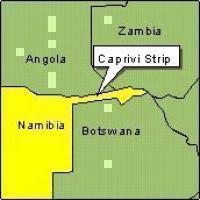







|
News and Information
Lusata Traditional Festival of the Mafwe People
| September 29, 2006 |
 Lusata Traditional Festival of the Mafwe People Lusata Traditional Festival of the Mafwe People
2006-09-29
By Andrew N. Matjila
There is an Old Lozi (African) saying: “Mu lute bana ba mina kaza linkau, mu sike mwa kutela ni zona kwa balimu.” Simply translated, it means: “Teach the young about the power of the bones (of the traditional healer), and do not take that knowledge with you to the grave.”
This is indeed a unique expression, seen against the background of the education our ancestors gave to their offspring. The African parent of today is hard put to bringing up the children under the desired Afro-centric guidelines, culture and tradition, and the virtues that make up the sum total of the ubuntu/butu, of which we black people are so proud. From the days of yore, when the first colonizers arrived, their fear was that of unexpected surprise attacks by black warriors. “Are the natives friendly?”
The English Empire Builders, such as John Rhodes, would pose the question to missionaries, invariably insinuating: “Will they play ball, to allow us free access to whatever we want?”
The Period of the ‘Missing Link’
Whereas it is generally known that in his theory on Evolution, the great scientistm, Dr Charles Robert Darwin, spoke of a Missing Link in the evolution of man, African also can refer to a similar missing link in its cultural development.
From the age of discoveries in the fifteenth century, to the twentieth century when Africans regained their land, a period of six to seven hundred years, black culture underwent many transformations.
The youth of today have to carry out in-depth research into this period, in order to find out how Africa would look like today were it to have remained uncolonized like other countries on the globe. In their quest for the truth, the youth must look at the situation in Africa before or around the era of colonization.
The facts that emerge should put our young leaders in a better position to evaluate and contrast the various scenarios, in order to conclusively determine whether their African forebears were useless, unintelligent or lacking in skills that could have brought us somewhere, in the same manner as many other nations who learned from others.
During the 1960s and 70s, many of the elders of the people of the Caprivi region could still remember the period known as the “period of the Mambari.”
Up to the late 1970s there were still many such guns around the region, kept in old tree trunks in the forest. Where the situation presented itself and the Zanzibaris outnumbered their villagers, there was no bargaining taking place.
The armed men and their assistants normally captured many victims and chained them to the long line of people on their way to Dar. Their final destination? America. Oh, what a sad day it was for our people, to be carted away like goods as it were, and to be sold by public auction like cattle. What a sad day it was.
And now, the wheel has turned full circle, as the saying goes. History’s wheels roll on and on, creating new situations, with new leaders emerging, and civilizations disappearing to make way for the new. In the early Fifties Egypt experienced a new revolution, brought about by soldiers who had grown tired of royalty and the easy life of their then vain, arrogant and spendthrift King Farouk.
The generals of that country teamed up and eventually succeeded in deposing Farouk, sending him into eternal exile. Nasser and others declared a republic and he became president. Little did they know then that the events they had unleashed would have far-reaching consequences for the entire African continent. Already in Namibia politicians were gearing up to fight for their liberation. In the same decade of the Fifties, Kwame Nkrumah followed Egypt, and Ghana became independent. Others were to follow hot on the heels of Ghana.
Now, what has all this to do with the Lusata celebrations, one may ask?
In the early 1960s, Mafwe Chief Simasiku Mamili joined Caprivi African National Union (CANU), in order to fight for freedom from colonial rule. His sole purpose was the total liberation of Namibia and freedom for his people
As a result of this political decision, his people experienced the brunt of the struggle, resulting in imprisonment for many in Pretoria and elsewhere, and death for people like Lyaboloma, Mukwali, Masida who was roasted alive and died a terrible death. While some of CANU’s leaders were arrested, including its President Simbwaye, some jumped borders and went abroad.
In 1971, Richard Temuso Muhinda took over from Simasiku Mamili, who abdicated because of old age. He was over a hundred years old.
At this period, the youth were leaving the region in large numbers to join SWAPO in Zambia, the new Political Movement that had emerged after OPO and CANU had disbanded in order to form a new party. The youth came from all ethnic groups in the Caprivi and South West Africa. The whole region was turned upside down, and schools started running empty.
Those who did not go into exile were not friendly to the authorities, labelling local leaders as “lipoto,” the Lozi word for puppets. The situation was desperate indeed, and the leaders did not have solutions to the problem of utilizing the political energy of the youth to create a new hope for the future. Hatred, name-calling and blame-apportioning were the order of the day.
Chief Mamili V, Richard Temuso Muhinda, then realized that one of the issues that warranted serious thought and action was the creation of a festival to commemorate past and present heroes of the people.
Such a feast day would be celebrated at his headquarters with pomp and ceremony, and would vibrate with traditional dances and speeches.
The culture of the people would focus on the past, present and future, including the first people to be taken into custody for ‘terrorism’ and flown to Pretoria for interrogation from the Mafwe area.
The years 1967/68–70 saw many subjects of Mamili arrested and thrown into prison in South Africa. When Richard Mamili finally committed pen to paper to design a special ‘Hero’s Festival,’ the decade of the Seventies was already in the setting sun. But with painstaking persistence and perseverance, the Lusata itself was completed and the launching took place on 26 September 1981. A great crowd attended the festival then, including teachers and schoolchildren alike, participating in the festivities.
Many of the sons and daughters of the Mafwe were still in exile at that time.
Now they are back, and must understand that this feast was not only brought about to honour the ancestors of old alone, but all those whose acts of bravery made the Mafwe people a proud people.
The sons and daughters who gather for the Lusata Festival each year in Chinchimani are in essence congratulating themselves on their achievements in politics, education, agriculture and many other fields of human endeavour, as well as the ancestors who lie buried beneath the turf at Linyanti and elsewhere in the region.
The Profile of the Lusata in its Glory
• Adorned by the elephant on top, the symbol of the Mafwe Traditional Authority Africans, like the Red Indians of North America, have totems to indicate their clans or tribes. The elephant is generally referred to as the gentle giant, not given to emotional outbursts of fury. But, when provoked, it becomes very dangerous.
• The letters ‘MTL’ come under the elephant, and stand for Mafwe Traditional Lusata, i.e. Mafwe Traditional Mace. Kings and all rulers through the ages always carried a symbol of power, used when issuing proclamations, orders, rules and laws. The mace is one such instrument of authority which can only be in the hands of a king, or ruler.
The Mafwe Mace, it must be emphasized here, is not for Tribal Authority but a Traditional institution. It is all-inclusive of Totela, Mafwe, Mbukushu, Yeyi, Mbalangwe and some San groups, all welded into one traditional group. Unity in diversity is the norm.
•The claws of the leopard carved under the elephant symbolize the power of the king, whose hands bear terrible weapons for attack and defence.
• The letters ‘RMM’ stand for Richard Muhinda Mamili, the King under whose rule the Lusata Festival was instituted. He was the fifth Mamili
• The Woven Tree, or the trunks that intertwine, represent the various groups in the Mafwe united under one Head.
• The Lusata is shafted onto a handle made of hardwood from the forests of the Mafwe area. The hardwood is a solid companion of the Lusata and symbolizes the solid earth upon which all the good things stand, i.e. the people, the flora and the fauna.
Finally, the Lusata annual Cultural Festival is therefore celebrated to foster and achieve a sense of unity in diversity and to remember the foundation laid down by the chiefs and other fallen heroes. It gives recognition to the continuation of the instruments of the culture of those who brought it about centuries ago.
The King of the Mafwe is a symbol of the unity of his people, having welded various tribes into one coherent unit from time immemorial. The Lusata depicts trees welded or interwined to make one, thus giving the assurance to the people that “United we shall stand, and divided we shall fall.”
Everything about the Lusata is as original as the culture itself, and nothing has been left to chance by copying from others, to make the Mafwe culture look like a rubber stamp.
The young should rest assured that their future will be safeguarded in the virtues, laws and guidelines embodied in the power of the Lusata, to make them proud, enlightened and staunch Namibians.
|
Source: www.newera.com.na |
| http://www.newera.com.na/archives.php?id=13370&date=2006-09-29 |
|
| Support Caprivi Freedom |
Fill out the form below to become a member of this site and receive our regular newsletter.
|

|

